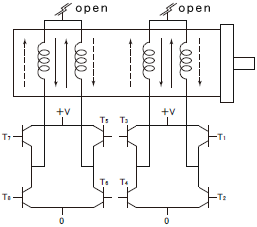Drive Circuitry
Drive circuitry is as shown below. The characteristics of the motor may vary due to the driving method.
Constant Voltage and Constant Current
A constant voltage driving method is not suitable for a high frequency drive. Stable performance is expected for the whole range of frequencies when a motor is driven with constant current.
Unipolar and Bipolar
Unipolar drive is the method in which the current flowing in the motor coils always flows in the same direction. (Figure 1.) Bipolar drive is the method in which the direction of the current flowing in the motor coils reverses for each timing pulse. It has more complicated circuit configurations than the unipolar drive, but it raises utilization efficiency of the motor coils. (Figure 2.)
Bipolar drive method is suitable in case high torque is required. Be aware that inductance value may increase due to a multiwinding. It is possible that unipolar drive has a much higher torque than bipolar.
Excitation Modes
2 phase, 1-2 phase mode and microstep, are basic excitation modes.
In the 2 phase excitation mode, the motor is driven with standard step angle. In 1-2 phase, step angle is halvedand in microstep, the step angle is resolved into pieces. In a smaller frequency, a smaller step angle creates much smoother movement.
The sequences are as shown in Figures 3 and 4.
Supply Voltage
In case of constant current drive, the motor performance may significantly vary by supply voltage. If a hi-speed drive is required while supply voltage is not occupied, a better performance is expected by allocating a higher voltage to the motor drive.
Figure 1 : Unipolar Drive

Figure 2 : Bipolar Drive

Figure 3 : 1-2 phase Excitation
スクロールできます
| step/phase | A | B |  |
 |
COM |
|---|---|---|---|---|---|
| 0 | - | 0 | 0 | 0 | + |
| 1 | - | - | 0 | 0 | + |
| 2 | 0 | - | 0 | 0 | + |
| 3 | 0 | - | - | 0 | + |
| 4 | 0 | 0 | - | 0 | + |
| 5 | 0 | 0 | - | - | + |
| 6 | 0 | 0 | 0 | - | + |
| 7 | - | 0 | 0 | - | + |
Figure 4 : 2 phase Excitation
スクロールできます
| step/phase | A | B | 
|

|
COM |
|---|---|---|---|---|---|
| 0 | - | - | 0 | 0 | + |
| 1 | 0 | - | - | 0 | + |
| 2 | 0 | 0 | - | - | + |
| 3 | - | 0 | 0 | - | + |
Related page
Engineering Information for PM stepping motors
Technical Data
Precautions of Use
Explanation of Technical Terms
Contact Us
Please click the inquiry type below according to your question. Each product / sales representative will respond to you.